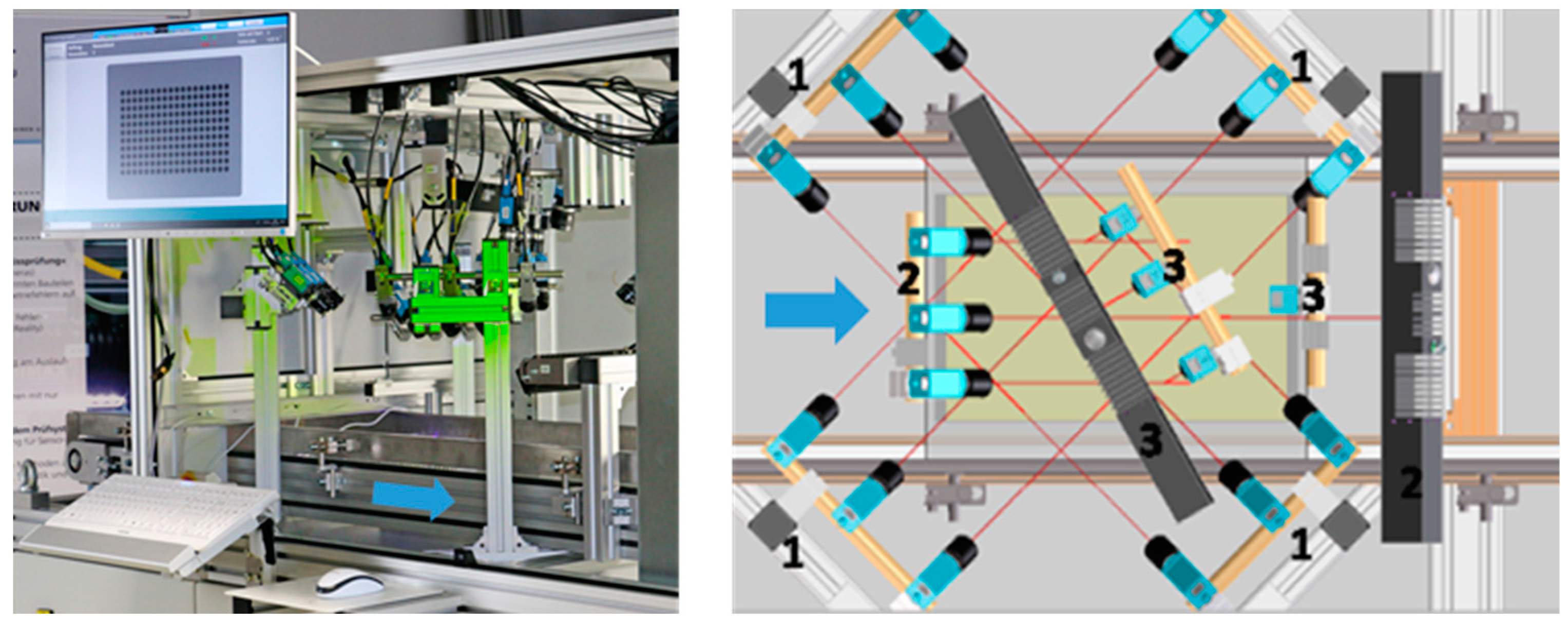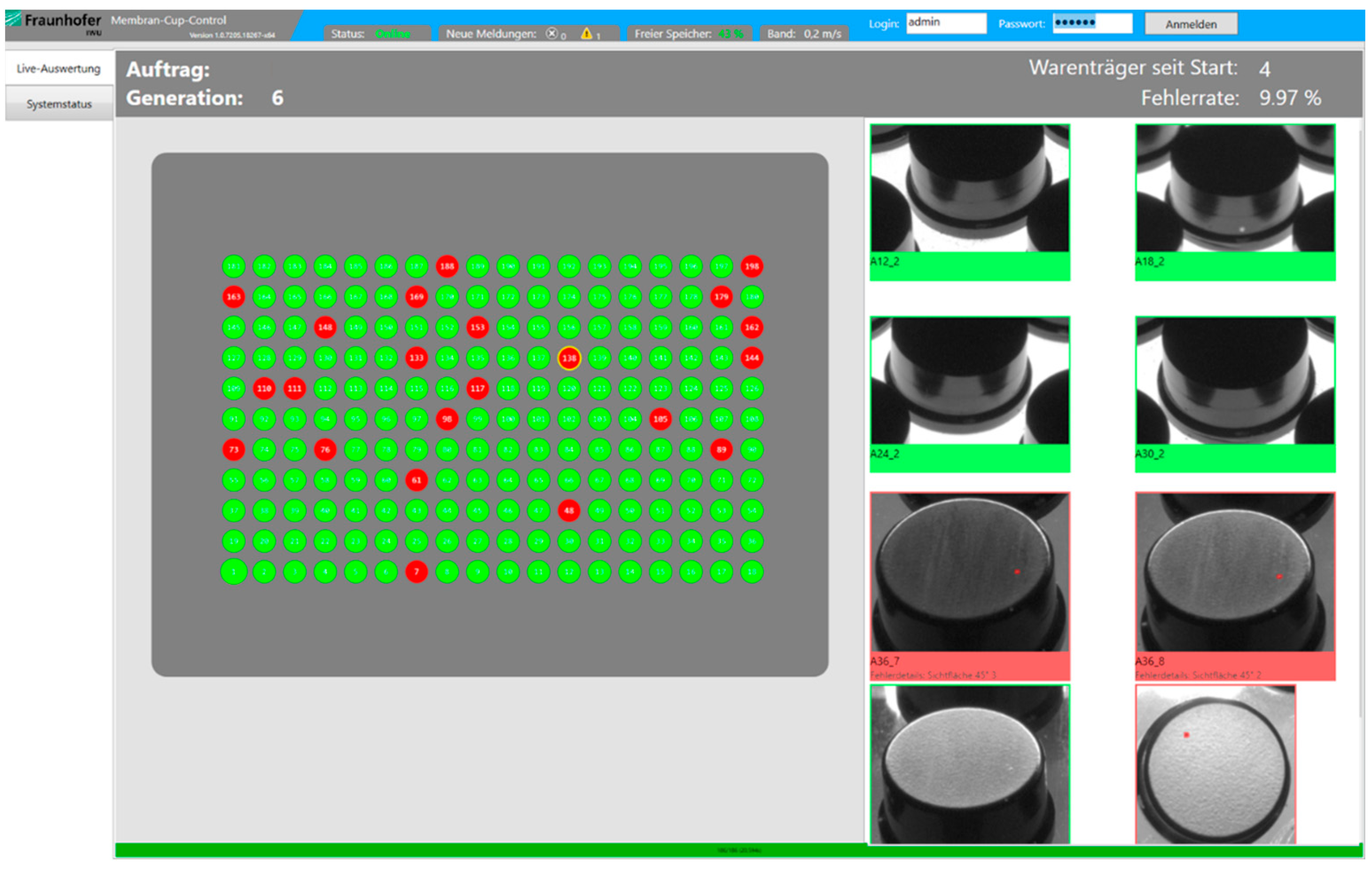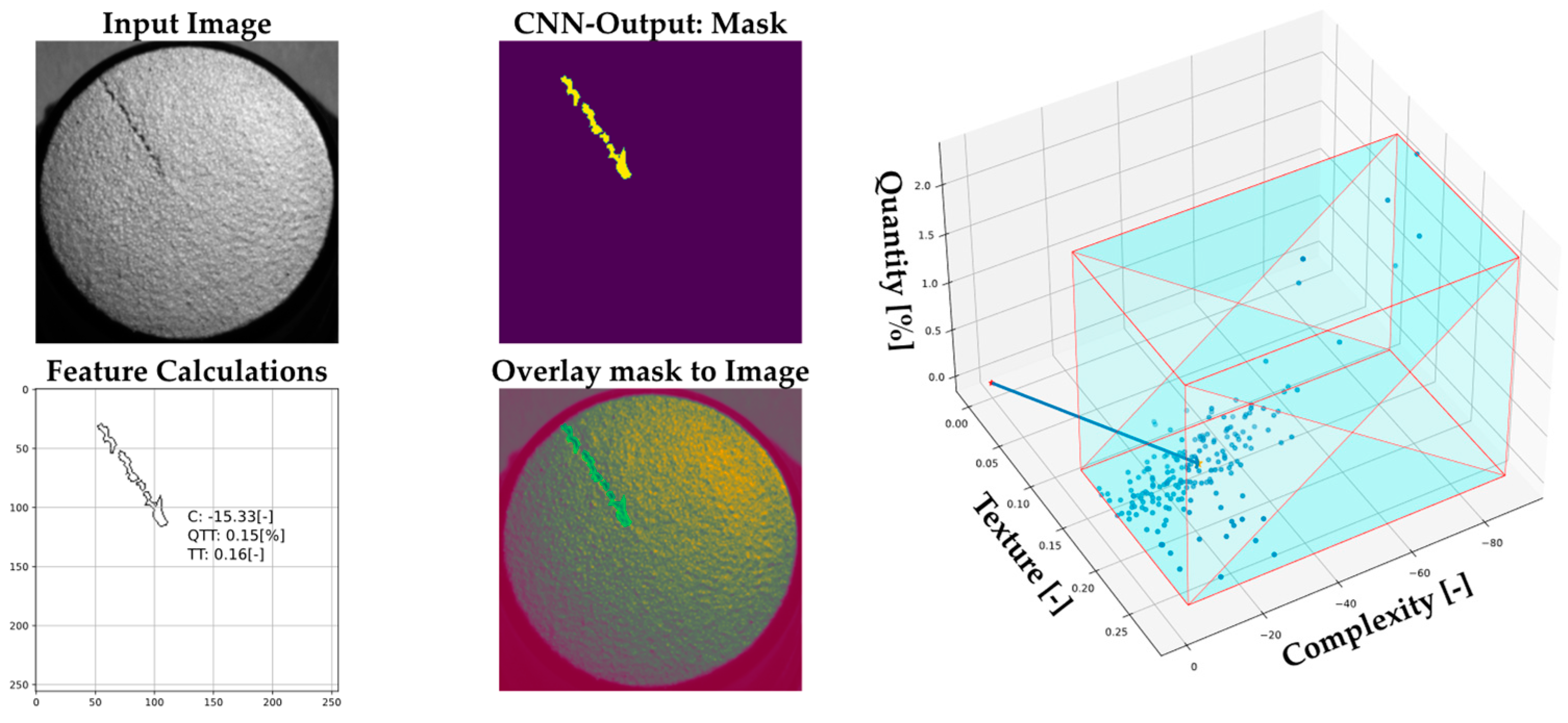Inline Quality Monitoring of Reverse Extruded Aluminum Parts with Cathodic Dip-Paint Coating (KTL)
Abstract
:1. Introduction
2. State of the Art
2.1. Coating Technology
2.2. Quality Control
2.3. Light Propagation in Paints
2.4. Color Spaces
3. Development of Multi-Camera Inline Monitoring Systems
3.1. Requirements for AOI System
3.2. Hardware of Inline Monitoring Systems
3.3. Software of Inline Monitoring Systems
| 1 | Image acquisition, including lens distortion correction. | |
| 2 | Cropping of image patches for each part from different perspectives. | |
| 3 | Pose correction—Due to clearance fit of the parts on the tray, the parts position can vary ±1 mm. The software compensates this deviation by applying a Euclidean transformation matrix to the patch using an enhanced correlation-based image registration algorithm [22]. | |
| 4 | Failure detection modules (for each patch) | |
| 4.1 Classical filter-based vision methods | 4.2 Machine learning methods | |
Detector application applied to masks for dedicated part areas:
| Anomaly quantification analysis (AQA). | |
| Comparison/thresholding to reference image of good-state parts. | ||
| Morphology operations andblob analysis of detector outputs. | ||
| 5 | Generation of failure output results. | |
| 6 | Protocolling of results, visualization, and outputting handshake signals to sorting robot. | |
4. Experimental Section
4.1. Classical Filter-Based Machine Vision Methods
4.2. Machine Learning Methods
- Gamma contrast by applying to the pixel values of the original image OP:
- Linear contrast modifies to OP by applying an alpha blending:
- Rotation augmentation changing the pixel-coordinated OP by rotating them around the image center.
5. Discussion
6. Conclusions
Author Contributions
Funding
Institutional Review Board Statement
Informed Consent Statement
Data Availability Statement
Conflicts of Interest
References
- VDA 16; Qualitätsmanagement in der Automobilindustrie: Dekorative Oberflächen von Anbau- und Funktionsteilen im außen- und Innenbereich von Automobilen; Beurteilungsbedingungen, Merkmalsdefinition und Fehleransprache, Annahmekriterien (Quality Management in the Automotive Industry: Decorative Surfaces of Add-On and Functional Parts in the Exterior and Interior of Automobiles; Assessment Conditions, Definition of Characteristics and Defect Approach, Acceptance Criteria). Heinrich Druck + Medien GmbH: Frankfurt am Main, Germany, 2008.
- Lesch, F. Einfluss von Substrateigenschaften auf die Abscheidung Übergangsmetallsalzhaltiger Korrosionsschutzmaterialien (Influence of Substrate Properties on the Deposition of Corrosion Protection Materials Containing Transition Metal Salts). Ph.D. Dissertation, Friedrich-Alexander-Universität, Nürnberg, Germany, 2014. [Google Scholar]
- VDI/VDE/VDMA 2632; Machine Vision: Part1: Basics, Terms, and Definitions; Part 2: Guideline for the Preparation of a Requirement Specification and a System Specification; Part 3: Acceptance Test of Classifying Machine Vision Systems. Beuth Verlag GmbH: Berlin, Germany,, 2021.
- Zhong, S. Progress in terahertz nondestructive testing: A review. Front. Mech. Eng. 2019, 14, 273–281. [Google Scholar] [CrossRef]
- Helmut Fischer GmbH. X-ray XRF Fluorescence. Available online: www.helmut-fischer.com/product-categories/x-ray-xrf (accessed on 21 July 2022).
- Giurlani, W.; Berretti, E.; Innocenti, M.; Lavacchi, A. Measuring the Thickness of Metal Coatings: A Review of the Methods. Coatings 2020, 10, 1211. [Google Scholar] [CrossRef]
- Tandiya, A.; Akthar, S.; Moussa, M.; Tarray, C. Automotive Semi-specular Surface Defect Detection System. In Proceedings of the 2018 15th Conference on Computer and Robot Vision (CRV), Toronto, ON, Canada, 8–10 May 2018; IEEE: Piscataway, NJ, USA, 2018; pp. 285–291, ISBN 978-1-5386-6481-0. [Google Scholar]
- Satorres Martínez, S.; Ortega Vázquez, C.; Gámez García, J.; Gómez Ortega, J. Quality inspection of machined metal parts using an image fusion technique. Measurement 2017, 111, 374–383. [Google Scholar] [CrossRef]
- Kozamernik, N.; Bračun, D. Visual Inspection System for Anomaly Detection on KTL Coatings Using Variational Autoencoders. Procedia CIRP 2020, 93, 1558–1563. [Google Scholar] [CrossRef]
- Völz, H.G. Industrial Color Testing: Fundamentals and Techniques, 2nd ed.; Wiley-VCH: Weinheim, Germany, 2001; ISBN 9783527304363. [Google Scholar]
- Vargas, W.E.; Niklasson, G.A. Applicability conditions of the Kubelka-Munk theory. Appl. Opt. 1997, 36, 5580–5586. [Google Scholar] [CrossRef] [PubMed]
- Dingemans, L.M.; Papadakis, V.M.; Liu, P.; Adam, A.J.L.; Groves, R.M. Quantitative coating thickness determination using a coefficient-independent hyperspectral scattering model. J. Eur. Opt. Soc.-Rapid Publ. 2017, 13, 40. [Google Scholar] [CrossRef] [Green Version]
- Luo, M.R. (Ed.) Encyclopedia of Color Science and Technology; Springer: New York, NY, USA, 2016; ISBN 978-1-4419-8070-0. [Google Scholar]
- ISO/CIE 11664-4:2019; Colorimetry. Part 4, CIE 1976 L*a*b* Colour Space. Deutsches Institut für Normung: Berlin, Germany, 2020.
- Herrle, T.F. Entwicklung und Erprobung eines Online-Lackmischverfahrens für die Automobilserienlackierung (Development and Testing of an Online Paint Mixing Process for Automotive Series Coatings); Cuvillier: Göttingen, Germany, 2012; ISBN 978-3-95404-301-9. [Google Scholar]
- Beau Lotto, R.; Purves, D. The empirical basis of color perception. Conscious. Cogn. 2002, 11, 609–629. [Google Scholar] [CrossRef] [PubMed]
- Nischwitz, A.; Fischer, M.; Haberäcker, P.; Socher, G. Band I: Computergrafik, 3rd ed.; Vieweg + Teubner: Wiesbaden, Germany, 2011; ISBN 9783834813046. [Google Scholar]
- Saravanan, G.; Yamuna, G.; Nandhini, S. Real time implementation of RGB to HSV/HSI/HSL and its reverse color space models. In Proceedings of the 2016 International Conference on Communication and Signal Processing (ICCSP), Melmaruvathur, India, 6–8 April 2016; IEEE: Piscataway, NJ, USA, 2016; pp. 462–466, ISBN 978-1-5090-0396-9. [Google Scholar]
- Viliūnas, V.; Vaitkevičius, H.; Stanikūnas, R.; Švegžda, A.; Bliznikas, Z. LED-based metameric light sources: Rendering the colours of objects and other colour quality criteria. Light. Res. Technol. 2011, 43, 321–330. [Google Scholar] [CrossRef]
- Gjakova, L.; Löser, R.; Klimant, P.; Dix, M. Decreasing the commissioning time of optical multi-camera inspection systems by simulating surface coverage using the example of formed bipolar plates. Eng. Proc. 2022, 26, 17. [Google Scholar]
- Putz, M.; Wiener, T.; Pierer, A.; Hoffmann, M. A multi-sensor approach for failure identification during production enabled by parallel data monitoring. CIRP Ann. 2018, 67, 491–494. [Google Scholar] [CrossRef]
- Pierer, A.; Wiener, T.; Gjakova, L.; Koziorek, J. Zero-error-production through inline-quality control of presshardened automotive parts by multi-camera systems. IOP Conf. Ser. Mater. Sci. Eng. 2021, 1157, 12074. [Google Scholar] [CrossRef]
- Mehrotra, R.; Namuduri, K.R.; Ranganathan, N. Gabor filter-based edge detection. Pattern Recognit. 1992, 25, 1479–1494. [Google Scholar] [CrossRef]
- Haralick, R.M.; Shanmugam, K.; Dinstein, I.H. Textural Features for Image Classification. IEEE Trans. Syst. Man Cybern. 1973, SMC-3, 610–621. [Google Scholar] [CrossRef]








Publisher’s Note: MDPI stays neutral with regard to jurisdictional claims in published maps and institutional affiliations. |
© 2022 by the authors. Licensee MDPI, Basel, Switzerland. This article is an open access article distributed under the terms and conditions of the Creative Commons Attribution (CC BY) license (https://creativecommons.org/licenses/by/4.0/).
Share and Cite
Pierer, A.; Hauser, M.; Hoffmann, M.; Naumann, M.; Wiener, T.; de León, M.A.L.; Mende, M.; Koziorek, J.; Dix, M. Inline Quality Monitoring of Reverse Extruded Aluminum Parts with Cathodic Dip-Paint Coating (KTL). Sensors 2022, 22, 9646. https://doi.org/10.3390/s22249646
Pierer A, Hauser M, Hoffmann M, Naumann M, Wiener T, de León MAL, Mende M, Koziorek J, Dix M. Inline Quality Monitoring of Reverse Extruded Aluminum Parts with Cathodic Dip-Paint Coating (KTL). Sensors. 2022; 22(24):9646. https://doi.org/10.3390/s22249646
Chicago/Turabian StylePierer, Alexander, Markus Hauser, Michael Hoffmann, Martin Naumann, Thomas Wiener, Melvin Alexis Lara de León, Mattias Mende, Jiří Koziorek, and Martin Dix. 2022. "Inline Quality Monitoring of Reverse Extruded Aluminum Parts with Cathodic Dip-Paint Coating (KTL)" Sensors 22, no. 24: 9646. https://doi.org/10.3390/s22249646





